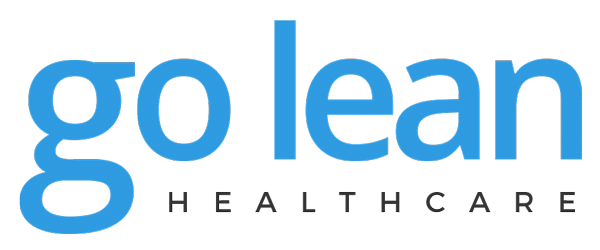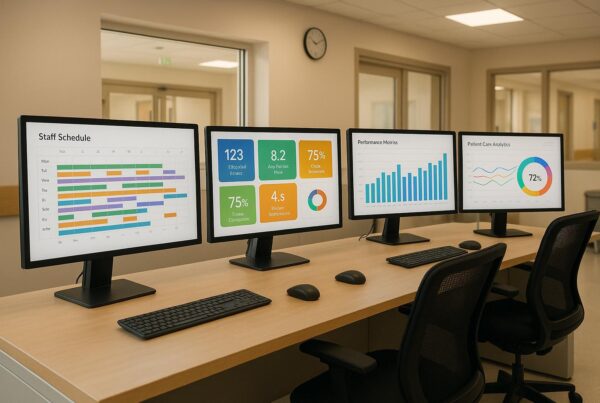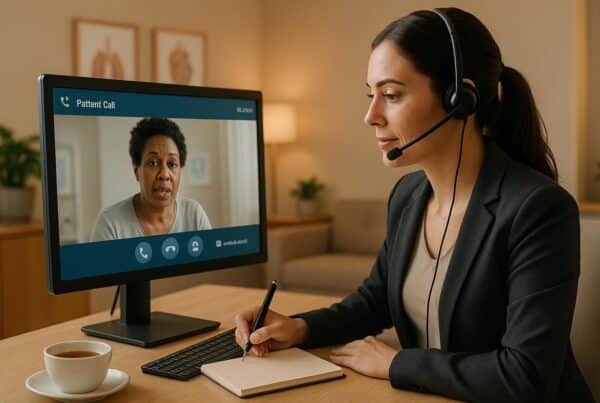Want to grow your medical or dental practice while cutting costs? Here’s the key: remote administrative support.
- Save Money: Remote teams can reduce operational costs by up to 30%.
- Boost Efficiency: Free up clinical staff by outsourcing tasks like scheduling, billing, and insurance verification.
- Focus on Patients: Spend more time on patient care, not paperwork.
- Use Technology: Tools like EHR systems, automated scheduling, and secure communication platforms make it seamless.
This approach helps small and mid-sized practices grow without increasing overhead. Ready to learn how? Let’s dive in.
Core Principles of Efficient Healthcare Growth
Defining Efficient Growth Methods
Efficient growth in healthcare is all about finding the sweet spot between expanding services and keeping costs in check. Data shows that smart automation and streamlined workflows can significantly reduce administrative expenses, making operations smoother and more cost-effective.
At the heart of efficient growth are two key pillars:
- Technology Integration Leveraging technology can transform how healthcare practices operate. Some tools that drive efficiency include:
- Electronic Health Records (EHR) systems
- Practice management software
- Automated appointment scheduling platforms
- Digital patient engagement tools
For example, using automated appointment reminders has been shown to reduce no-show rates from 20% to just 4%, resulting in an additional $7,500 in monthly revenue [4].
- Staff Optimization A well-optimized team can make a huge difference. Effective strategies include:
- Cross-training staff to handle multiple roles
- Using performance metrics to track and improve efficiency
- Investing in employee development and outsourcing non-core tasks
Prioritizing staff development not only enhances skills but also improves retention rates [6].
By focusing on these two pillars, healthcare organizations can create a strong foundation for growth while addressing the challenges of traditional staffing models.
Limits of In-House Staff Expansion
Even with effective growth strategies, relying solely on in-house staff expansion comes with its own set of challenges. This is where remote administration can offer valuable solutions.
| Cost Category | In-House | Remote Administration |
|---|---|---|
| Physical Space | Requires more office space and equipment | Eliminates facility costs |
| Benefits & Insurance | Full benefits required | Reduces overhead with remote specialists |
| Training & Development | High onboarding time and costs | Access to pre-trained professionals |
| Scheduling | Limited to standard office hours | Provides flexible coverage options |
To allocate resources wisely, practices can explore strategies like:
- Standardizing and bundling service contracts to save costs [6]
- Streamlining patient flow to reduce delays and waiting times
- Incorporating telehealth for appropriate visit types [5]
- Negotiating supplier contracts annually for better rates [5]
For instance, a dental practice was able to cut sterilization supply costs by over 20% simply by optimizing the sizes of sterilization wraps [3]. These kinds of adjustments can make a big impact on operational efficiency and overall cost management.
Remote Medical Administration: Implementation Guide
Top Tasks for Remote Staff
Remote medical administration has reshaped how healthcare operations are managed. Here are some of the key responsibilities handled by remote staff:
Core Administrative Tasks:
- Insurance verification
- Appointment scheduling
- Medical billing and coding
- Patient records management
- Telehealth coordination
Research indicates that physicians spend nearly half (49%) of their workday on administrative duties [7]. Delegating these tasks to remote staff allows doctors to focus more on patient care.
Cost Analysis: Remote vs. In-House Staff
Switching to virtual assistant services can reduce operational expenses by 25% [7]. This is achieved through lower hourly rates and the elimination of costs tied to benefits, office space, equipment, and training. By cutting these overheads, practices can allocate more resources to improving patient care.
Remote Staff Integration Process
To fully capitalize on the cost savings and efficiency gains, integrating remote staff into your practice requires careful planning. Here’s how to do it:
- Assessment and Planning
Start by analyzing your current workflow. Determine which tasks can be handled remotely, document the processes, and establish clear performance benchmarks. - Technology Setup
Equip your practice with the necessary tools for remote work, such as:- EMR (Electronic Medical Records) access protocols
- HIPAA-compliant communication platforms
- Practice management software
- Secure file-sharing systems
- Staff Training
Provide comprehensive training for your remote team, covering:- Practice-specific protocols
- HIPAA compliance standards
- EMR system navigation
- Communication guidelines
"Evo Care Medical Billing helped AIMS Florida increase patient enrollments and achieve 233% revenue growth within six months."
– Diane Baucom, Chronic Care Manager, AIMS Florida [7]
To maintain alignment with practice objectives, conduct regular performance reviews and feedback sessions. This ensures that remote staff continue to deliver high-quality service while adapting to the evolving needs of the practice.
𝐖𝐡𝐲 𝐄𝐯𝐞𝐫𝐲 𝐇𝐞𝐚𝐥𝐭𝐡𝐜𝐚𝐫𝐞 𝐏𝐫𝐚𝐜𝐭𝐢𝐜𝐞 𝐍𝐞𝐞𝐝𝐬 𝐑𝐞𝐦𝐨𝐭𝐞 𝐌𝐞𝐝𝐢𝐜𝐚𝐥 𝐀𝐬𝐬𝐢𝐬𝐭𝐚𝐧𝐭 𝐒𝐮𝐩𝐩𝐨𝐫𝐭?
Digital Tools for Healthcare Administration
Digital infrastructure plays a crucial role in maintaining administrative efficiency, especially as remote healthcare administration continues to grow. A striking 88% of office-based physicians now use Electronic Health Records (EHRs), with 78% relying on certified systems to manage their workflows effectively [9].
Essential Software and Systems
Efficient remote healthcare administration hinges on the right digital tools. Here’s a closer look at the key systems driving this transformation:
Electronic Health Records (EHR) Systems
Modern EHR platforms are at the heart of healthcare administration, offering advanced tools to manage patient data and streamline operations. For example, OmniMD combines AI-driven clinical decision support with revenue cycle management, while NextGen Healthcare provides specialty-focused templates and built-in telehealth solutions [9].
Patient Intake Management
Simplifying the pre-visit process is critical, as 77% of patients prefer completing digital forms before their appointments [8]. Leading platforms in this space include:
| Platform | Key Features | Integration Capabilities |
|---|---|---|
| Phreesia | Online scheduling, digital check-in, payment processing | Compatible with multiple EHR systems |
| Luma Health | AI-powered patient access, automated communication | Works with major EHR platforms |
| Klara | Two-way messaging, task automation | Centralized communication hub |
Practice Management Software
These tools ensure smoother daily operations and improved efficiency. Popular options include:
As healthcare systems embrace these digital tools, the importance of robust security measures becomes even more pronounced.
Data Security and HIPAA Guidelines
Optimizing administrative processes is only part of the equation; protecting sensitive data is equally critical. With healthcare data breach costs climbing by 53.3% since 2020, implementing strong security protocols is non-negotiable [12].
Encryption Requirements
To safeguard patient information:
- Encrypt data end-to-end, both in transit and at rest.
- Use HIPAA-compliant communication tools to minimize risks.
Access Control Protocols
Access management is vital for maintaining security. Best practices include:
- Multi-factor authentication for all users.
- Role-based permissions to limit access to sensitive data.
- Comprehensive audit logging to track activity.
- Regular reviews of access permissions.
"HIPAA offers recommendations but doesn’t specifically require healthcare organizations to implement data encryption measures; instead, the rule leaves it up to healthcare providers and business associates to determine what encryption methods and other measures are necessary or appropriate given the organization’s workflow and other needs." – Health IT Security [11]
Security Monitoring
With 82% of healthcare data breaches involving cloud-stored information, proactive monitoring is essential [12]. Best practices include:
- Conducting regular security risk assessments.
- Deploying intrusion detection systems to catch potential threats.
- Using separate networks for IoT devices to minimize vulnerabilities.
- Implementing continuous monitoring to identify and address risks in real-time.
Lastly, ensure HIPAA compliance by establishing Business Associate Agreements (BAAs) with all software providers and conducting routine security audits. These measures not only protect patient data but also reinforce trust in remote healthcare systems.
sbb-itb-109dad4
Patient Service Improvements
Building on streamlined operational efficiencies, remote support is transforming patient services. By simplifying processes and reducing the chances of miscommunication – an issue responsible for 80% of serious medical errors [13] – remote support creates a smoother and safer patient experience.
Faster Administrative Processing
Remote support systems are reshaping essential administrative tasks like appointment scheduling, insurance verification, and pre-visit documentation. By incorporating automated tools and remote staff, healthcare practices can efficiently handle:
- Digital intake forms: Simplifying patient information collection.
- Automated appointment reminders: Reducing missed appointments.
- Insurance verification: Speeding up approvals.
- Patient history updates: Ensuring accurate and up-to-date records.
These tools not only save time but also help bridge communication gaps, making the process more seamless for both patients and staff.
Language Support Options
Clear communication is critical in healthcare, and multilingual support plays a vital role in achieving it. Research shows that when patients receive clear explanations about their conditions, they are 30% less likely to face hospital readmissions [14].
Benefits of Multilingual Support:
- Availability of Spanish-speaking staff and other language specialists.
- Fewer misunderstandings during medical consultations.
- Better patient understanding of treatment instructions.
- Increased adherence to prescribed care plans.
By removing language barriers, healthcare providers can significantly improve patient outcomes and satisfaction.
Success Examples
The results of these improvements speak for themselves:
- Patient satisfaction: 42% of healthcare providers reported higher patient satisfaction after implementing remote support systems [14].
- Trust in providers: 80% of patients expressed greater trust in their healthcare providers when remote support was combined with educational initiatives [14].
Remote support enables practices to focus more on direct patient care while automating routine tasks like appointment reminders and follow-ups. This not only reduces no-show rates but also frees up in-house staff to provide more personalized attention, ultimately enhancing the overall patient experience.
Progress Tracking and Optimization
Keeping a close eye on performance is key to getting the most out of remote support in healthcare. By monitoring key performance indicators (KPIs) and regularly reviewing outcomes, practices can fine-tune their processes and maintain steady growth. This approach builds on earlier operational efficiencies and ensures ongoing improvements.
Performance Metrics
Tracking the right metrics can directly impact both efficiency and care quality. Here are some of the key categories to focus on:
| Metric Category | Key Measurements | Example Targets |
|---|---|---|
| Operational Efficiency | Task completion rates, response times, first call resolution | Practice-defined benchmarks |
| Financial Impact | Revenue per patient visit, patient volume | Around $31 more per visit; 10–15% volume growth [16] |
| Patient Experience | Stakeholder satisfaction, appointment attendance | High satisfaction; minimal no-shows |
| Technical Performance | System uptime, HIPAA/security compliance | Industry standards (e.g., >99.9% uptime) |
According to JAMA, practices that implemented virtual support systems saw an average revenue increase of $31 per patient visit and a 10–15% rise in patient volume [16]. This translates to an additional $150,000 to $200,000 in annual revenue per provider [16].
Regular Assessment Process
Incorporating these metrics into your remote administrative system helps ensure measurable and responsive growth. Here’s how practices can stay on track:
- Weekly Performance Reviews: Regularly evaluate task completion and accuracy. Use benchmarks and dashboards to quickly spot and address issues [15].
- Monthly ROI Analysis: Take a closer look at both cost savings and revenue generation. Assess factors like reduced administrative costs, time saved, increased patient capacity, and extra revenue from additional appointments.
- Quarterly System Optimization: Focus on improving workflows to eliminate inefficiencies. For example, one practice managed to cut its email bounce rate from 12.3% to 2.1% in just two months by prioritizing system updates [15].
Conclusion
Growing a medical or dental practice efficiently often comes down to smart strategies – like integrating remote administrative support. Research shows this approach can trim operational costs by up to 30% compared to traditional staffing models [1].
Remote support doesn’t just save money; it transforms operations. It reduces overhead, gives providers more time to focus on patients, and even enhances care quality. For example, it can cut patient wait times by 15–20 minutes, increase satisfaction rates by 25–30%, and ensure round-the-clock accessibility [17]. These benefits also help ease physician burnout, creating a better environment for both patients and providers [18].
Looking ahead, the potential for growth in the healthcare sector is immense. The global dental services market alone is forecasted to hit $610.4 billion by 2030, with an annual growth rate of 4.5% [2]. Practices that embrace remote support and AI-driven tools are well-positioned to tap into these opportunities while staying efficient and competitive.
The real challenge lies in execution. Success depends on implementing these systems thoughtfully, tracking their performance regularly, and making ongoing improvements. As healthcare continues to evolve, practices that adapt and innovate will be better prepared to grow while delivering top-notch patient care and maintaining provider satisfaction. Regular monitoring and fine-tuning of these systems will be crucial for staying ahead.
FAQs
How can medical and dental practices maintain HIPAA compliance and protect patient data when using remote administrative support?
To ensure HIPAA compliance and protect patient information, medical and dental practices need to focus on secure systems and procedures. Begin by using encrypted communication channels and enabling multi-factor authentication to restrict access to sensitive data to authorized personnel only.
It’s also essential to have clear data management policies in place, provide regular staff training on HIPAA rules, and rely on HIPAA-compliant software for any remote administrative work. Routine audits and updates to security measures can help maintain both compliance and data protection.
How can I effectively train and manage remote administrative staff to ensure efficiency and excellent patient care?
To effectively train and manage remote administrative staff in healthcare, start by establishing clear communication channels. Regular virtual meetings, updates, and consistent check-ins help ensure everyone stays aligned with your practice’s objectives and expectations.
Invest in focused training that covers critical areas like using technology tools, understanding HIPAA compliance, and handling patient interactions. This preparation ensures your team is equipped to perform their roles confidently and competently.
Create a supportive and collaborative environment by offering continuous guidance, tracking performance, and celebrating achievements. These efforts not only keep your team motivated but also foster engagement. With streamlined processes and open communication, you can maintain operational efficiency while delivering excellent patient care in a remote setting.
How can remote administrative support enhance patient care and satisfaction in medical and dental practices?
Remote administrative support plays a key role in improving patient care and overall satisfaction by making daily operations more efficient. When tasks like scheduling appointments, managing billing, and handling patient follow-ups are managed remotely, healthcare practices can dedicate more time and energy to providing quality care.
This setup also helps cut down on missed appointments, ensures prompt communication with patients, and reduces wait times – all of which create a smoother and more positive experience for patients. By streamlining workflows, practices not only operate more efficiently but also build stronger patient trust, leading to greater satisfaction.



